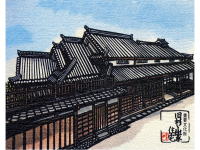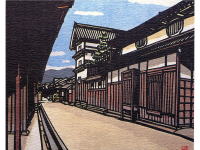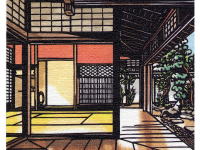富田林寺内町の探訪
I'm glad to intorduce an old town, Jinaimachi, Tondabayashi, Osaka, Japan as a national historic district and heritage site.
It takes 30 minutes from Osaka city to Tondabayashi station by Kintetsu railways. A 10-minutes walk will take you to the historic town.
ギャラリー
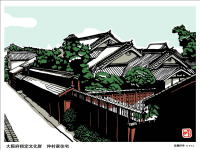
Key information
1. Historic preservation district
2. Former Sugiyama residence
3. Old town houses and temples
Historic buildings in jinaimachi town, tondabayashi, japan
| Koushoji Betsuin Buddhist Temple Open to the public Built in 1638 Location: Jyonomonsuji Street・Sakai Avenue |
|||||
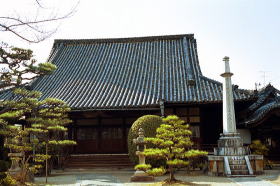 |
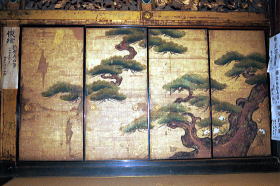 |
||||
| In the Eiroku Period (1558-69), Rev. Shoshu of the Ikko Sect of Buddhism
built Koushoji Betsuin, which is also called Tondabayashi Gobo. With this
temple as its center, Tondabayashi Jinaimachi developed and prospered.
Rev. Shoshu was not a mere priest but was a foreseeing town planner. Determined
to build the temple, he acquired a part of uncultivated grassland on top
of the Ishikawa River terrace for 100 kanmon (an ancient unit of money).
He requested of 8 shouya village headmen, two each from neighboring 4 villages,
to cooperate with him for the building of the temple, the cultivation of
fields and the construction of a town. Thus, the prototype of Jinaimachi
took shape. Koushoji is officially called Koryushohoji. It was originally at Yamashina, Kyoto but it was burned down in 1532. Later, Rev. Renshu renamed Temma Betsuin the principal temple of Koushoji. Since Rev. Shoshu was the son of Renshu, the temple he built was called betsuin or a branch temple. Koshoji Betsuin has its Main Gate opening on the east side of the precincts and includes the Bell Tower and the Drum Tower on the south and north parts of the precincts, respectively. Entering from the main gate, you will see the Main Temple in front of you and the Reception Hall and the priest's living quarters including a study on the right-hand side of the main temple. The existing main temple was rebuilt in 1638 and the buildings in the priest's private quarters were renewed in 1810. It is said that the main gate was moved from Fushimi Castle, while the bell tower and the drum tower were relocated to the present places in 1810. The outer chamber of the main temple is decorated with paintings on the sliding paper doors that were drawn by Kano Juseki Hidenobu, a noted painter of the Kano school. Although almost all original structures of Koshoji Betsuin have been lost, the present temple stands on nearly the same location of its predecessor. The main temple is the oldest Jodo Shinshuu Sect-style seminary remaining in Osaka Prefecture. It is a priceless structure with the prestige and beauty that suits the history-honored Jinaimachi. |
|||||
| Former Sugiyama family residence (an old merchant town house) Designated as an important national cultural property in Japan Open to the Public, closed on Mondays Built in 1644 Location: Ichiba Street, West Hayashi Avenue Trade name: Wataya Used to be a Japanese Sake Liquor brewery and wholesale distributor |
|||||
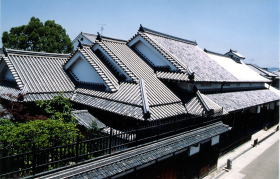 |
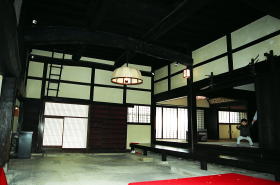 |
||||
| The Sugiyama family is an old family, which continued for generations from
the foundation of Jinaimachi, and successive heads of the family used the
name of Chozaemon Sugiyama. They administrated the town as one of
the Hachinin-shu (8 administrators) throughout the Edo era. The old family business is not clear, but after they obtained a brewery license in the 2nd year of Teikyo era (1685) , they succeeded as a brewery. As a brewer, this family played a leading role in the sake brewing industry of Minami-Kawachi. They enjoyed rapid progress and increasing the production of sake from at first 30 koku (an old unit of rice volume, 1 koku=47.654 U.S. gallons), to 104 koku in the fifth year of the Tenmei era (1785). It is said that as many as 70 employees worked there at its peak. The premises of the Sugiyama Family residence were large enough to occupy one whole block in the town zoning according to a community map drawn some time in the Edo Period. The premises consisted of 10 or more structures including the family's residence, breweries, rice steaming plants and warehouses. The scale well reflected the family's prosperity. The main feature of this house is a four-layered big roof. The old tradesman’s houses in Jinaimachi have simple structures like a farmhouse. For example, it has a big beam which supports the hanging wall to stop smoke from the cooking stove. Zashiki (a room) and second story was added afterwards. It is considered that the present structure of the house was settled in about the 4th year of the Enkyo era (1747). The walls around the rooms are reddish Osaka style walls and the luxurious pictures on Fusuma (Japanese paper sliding doors) are works of the painter belonging to the Kano school. The old Sugiyama house is the oldest merchant’s house among these private houses, large in scale and in superior in quality, therefore it was designated as an import cultural property on December 26th, 1983. (Quoted from the Web site of Tondabayashi city) |
|||||
| Nakamura family residence (an old merchant town house) Designated as a cultural properties of Osaka Prefecture Not open to the public built in 1782-83 Location : Tomi Suji Street, West Hayashi Avenue Trade name: Sadoya Used to be a Japanese Sake Liquor brewery and wholesale distributor |
|||||
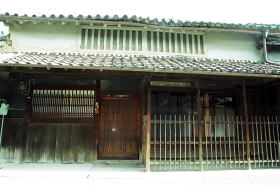 |
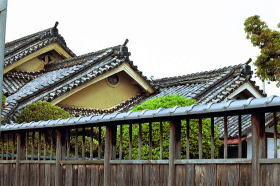 |
||||
| The Nakamura Family was engaged in sake brewery in the trade name of Sadoya.
All successive heads of the family passed under the name of Tokubei. Since obtaining the sake brewing right in 1715, the family greatly prospered as a brewer with its annual output reaching 2,135 koku in 1785. The head of the family was appointed the chief director of a brewers' guild in Kawachi, present-day Osaka Prefecture, in 1792. The guild controlled sake sale and shipments to the Edo (now Tokyo) market. It is known from archival housing records that the main structure in the premises of the old Nakamura Family residence was built some time between 1782 and 83. The office in the west of the main building and three separate drawing rooms in the south are found to share these construction dates as well. Successive heads of the family received many noted men of letters, painters and calligraphers in these drawing rooms. Yoshida Shoin, a military theorist towards the end of the Edo Period, is said to have been among these celebrities. (Quoted from the Web site of Tondabayashi city) |
|||||
Information
Location
Jinaimachi town, Tondabayashi city, a national historic preservation district
and heritage site of Japan, which is located in the south-eastern part
of Osaka prefecture, the western part of Japan
Access
Jinaimachi town is located in 10 minutes walk from Kintetsu Tondabayashi
station. Would you please drop in Jinaimachi Kouryuukan, or visitor center,
to get the town information?
From Kansai International Airport
Airport Limousine Bus service available bound for Kawachi Nagano Station.
(60 minutes) Please take Kintetsu railways from Kawachi Nagano to Tondabayashi.(15
minutes)
From Osaka International Airport (Itami Airport)
Airport Limousine Bus service available bound for Abenobashi Station. (30
minutes) Please take Kintetsu railways from Abenobashi terminal to Tondabayashi.(30 munites)
From JR Shinkasen Shin-Osaka station or
Osaka (Umeda) station
Please take Subway Midousuji line from Shin-Osaka station or Osaka (Umeda)
station to Tennoji Station. (20~30 minutes) Please change trains at Tennoji
and take Kintetsu railways from Abenobashi terminal to Tondabayashi. (30
minutes)
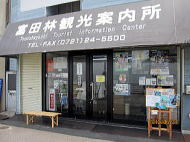
Tourist Information Center
Located in front of Kintetstu Railways Tondabayashi Station
Address.
19-10, Honmachi, Tondabayashi city, Osaka, 584-0093, Japan
TEL.+81-721-24-5500
FAX.+81-721-24-5500
open 8:45a.m. until 4 p.m.
closed on Monday & Aug.13 through Aug.15 and Dec.28 through Jan.4
![]()
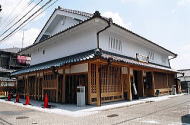
Jinaimachi Kouryuukan,
Town Community Center
(Visitor Center)
Address
9-29, Tondabayashi-cho, Tondabayashi city, Osaka, 584-0033, Japan
TEL.+81-(0)721-26-0110
FAX.+81-(0)721-26-0110
open 10a.m. until 5 p.m.
closed on Monday
Sightseeing Map
Available at Tourist Information Center and Jinaimachi Kouryuukan, visitor
center.
Restrooms
Available at Jinaimachi Kouryuukan, Jinaimachi Center and Jinaimachi Tenbou
Hiroba (Viewing Terrace)
Visitor Parking
Only available off the location of Jinaimachi town. Visitors are requested
not to drive cars into the area of Jinaimachi town.
